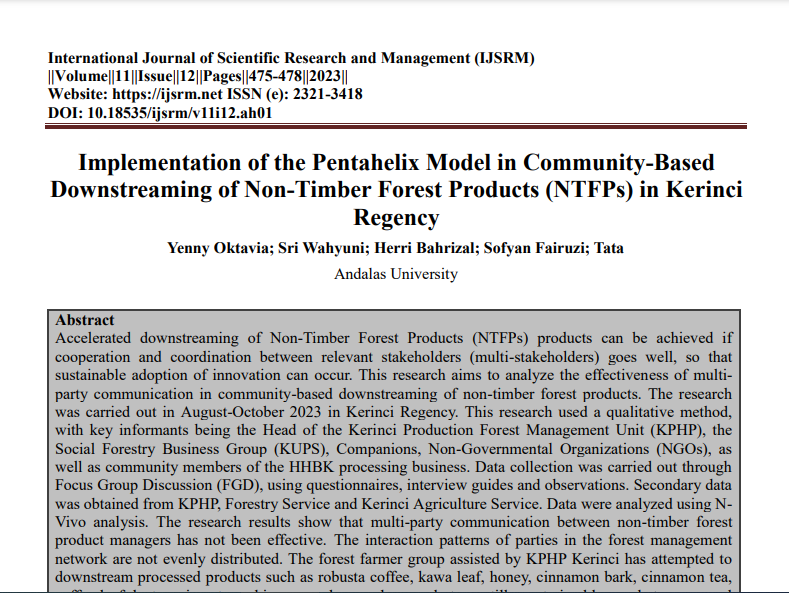Implementation of the Pentahelix Model in Community-Based Downstreaming of Non-Timber Forest Products (NTFPs) in Kerinci Regency

Submission to VIJ 2023-12-02
Keywords
- Communication effectiveness, multi-party, innovation
Copyright (c) 2023 Yenny Oktavia, Sri Wahyuni, Herri Bahrizal, Sofyan Fairuzi, Tata

This work is licensed under a Creative Commons Attribution 4.0 International License.
Abstract
Accelerated downstreaming of Non-Timber Forest Products (NTFPs) products can be achieved if cooperation and coordination between relevant stakeholders (multi-stakeholders) goes well, so that sustainable adoption of innovation can occur. This research aims to analyze the effectiveness of multi-party communication in community-based downstreaming of non-timber forest products. The research was carried out in August-October 2023 in Kerinci Regency. This research used a qualitative method, with key informants being the Head of the Kerinci Production Forest Management Unit (KPHP), the Social Forestry Business Group (KUPS), Companions, Non-Governmental Organizations (NGOs), as well as community members of the HHBK processing business. Data collection was carried out through Focus Group Discussion (FGD), using questionnaires, interview guides and observations. Secondary data was obtained from KPHP, Forestry Service and Kerinci Agriculture Service. Data were analyzed using N-Vivo analysis. The research results show that multi-party communication between non-timber forest product managers has not been effective. The interaction patterns of parties in the forest management network are not evenly distributed. The forest farmer group assisted by KPHP Kerinci has attempted to downstream processed products such as robusta coffee, kawa leaf, honey, cinnamon bark, cinnamon tea, coffee leaf dent, various taro chips, serundeng and so on, but are still constrained by market access and capital. , as well as its institutions. This means that the success of social forestry is not enough to only rely on strengthening one aspect, but must go hand in hand and complement each other.
References
- Heryadi, Yadi, dkk. 2022. Model Implementatif Agribisnis Padi Organik Berkelanjutan Melalui Pendekatan Pentahelix. Jurnal Agribest. 6 (1). 1-10
- https://media.neliti.com/media/publications/218030-konsep-dasar-kewirausahaan-dan-proseske.pdf
- Makmur & Thaiher, Rohana. 2015. Inovasi dan Kreativitas Manusia dalam Administrasi dan Manajemen. Bandung. Refika Aditama
- Potensi Sumberdaya Alam di Kabupaten Kerinci. Kumparan.com
- Saputra, Yoga Aldi & Ulum, Mochamad Chazienul. 2022. Peran Multi Aktor dalam Pemberdayaan Petani Kopi Berbasis Penta Helix. Jurnal Governansi. 8 (2). 115-130 Sembiring, Hafni Sagita. 2021. Analisis Kelayakan Finansial Bisnis Hasil Hutan Bukan Kayu (HHBK) KPHP Unit 1 Kerinci. Skripsi. Fakultas Pertanian. Jambi. Universitas Jambi
- Soemaryani, Imas. (2016). Pentahelix Model To Increase Tourist Visit To Bandung And Its Surrounding Areas Through Human Resource Development. Academy of Strategic Management Journal, Volume 15, Special Issues 3, 2016.
- Syandi, Melli. 2017. Komunikasi Konvergensi Menuju Kesepahaman Bersama (Mutual Understanding) dalam Pembangunan Pertanian.
- Virgawati, S & Murdiyanto, E. 2020. Kolaborasi PentaHelix dalam Mendukung Peningkatan Produksi Kopi Berkualitas di Temanggung. Prosiding Seminar Nasional. Fakultas Pertanian UPN “Veteran”. 334-344